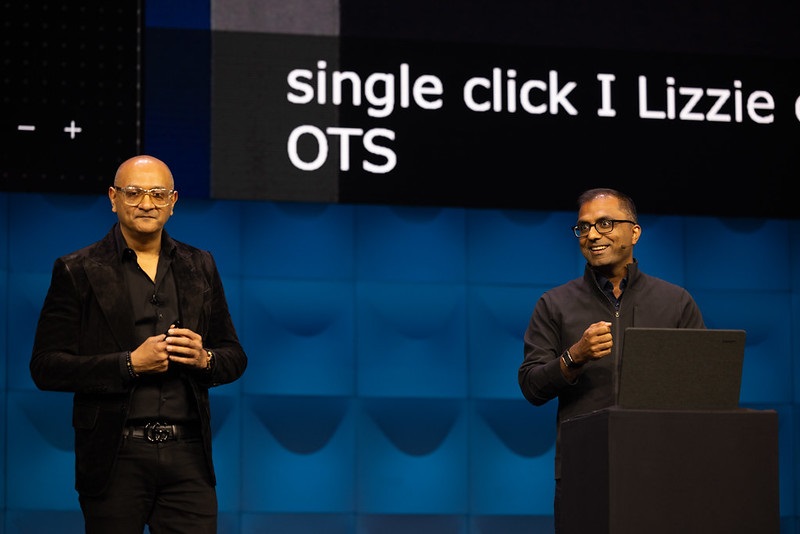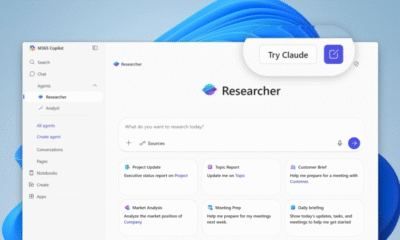Tech News
The Importance of Machine Data in Enhancing Your AI Strategy: Insights from Cisco

Cisco’s Vision: Every Product Company Must Embrace AI Models
Cisco executives argue that the line between traditional product companies and AI model companies is blurring. They emphasize the importance of tapping into the 55% of enterprise data growth that current AI systems overlook, asserting that this will be a defining factor that sets successful companies apart from the rest.
Recently, VentureBeat had the opportunity to speak with Jeetu Patel, President and Chief Product Officer at Cisco, and DJ Sampath, Senior Vice President of AI Software and Platform. Both leaders shared insights into a compelling thesis they both advocate. They believe that in the coming years, every thriving product company will need to transition into an AI model company to remain competitive.
The rapid evolution of product cycles, coupled with the efficiency of digital twin technology in expediting the launch of next-generation products, further supports this thesis.
The discussion shed light on the inevitability of this transformation, supported by solid data. The team highlights that a significant portion (55%) of data growth comprises machine data that current AI models do not leverage. Greg Brockman from OpenAI estimates that a staggering 10 billion GPUs are needed to equip every individual with the necessary AI tools. Notably, Cisco’s open-source security model, Foundation-Sec-8B, has already garnered 200,000 downloads on Hugging Face.
The Convergence of Product and Model Companies
VentureBeat: You’ve mentioned that every product company will eventually transition into a model company. Why is this shift not just a possibility, but an inevitable evolution?
Jeetu Patel: In the future, the distinction between product and model companies will cease to exist. The success of a product company will hinge on its ability to integrate AI models seamlessly. The symbiotic relationship between models and products forms a closed loop. Enhancing the product entails enhancing the underlying model, rather than superficial UI adjustments.
Companies that merely act as a facade for existing models are on borrowed time. The real competitive edge lies in the model that drives product functionality. This demands proficiency in two crucial areas: developing robust models in data-rich domains and creating exceptional product experiences driven by these models in a continuous feedback loop, allowing for model adaptation and evolution in response to product enhancements.
DJ Sampath: The significance of this shift is amplified when considering the transition towards agent-based systems. Agents will be governed by these models, underscoring the criticality of a model’s responsiveness to evolving requirements.
Unlocking the Potential of Machine Data Growth
VentureBeat: You’ve highlighted that a substantial portion of data growth comprises machine data that is currently underutilized by AI models. Why is this an immense opportunity for businesses?
Patel: Historically, AI models have predominantly been trained on publicly available human-generated data accessible on the internet. However, the well of public data has run dry. The next frontier lies within enterprise data repositories.
Although a significant proportion (55%) of data growth is attributed to machine data, existing AI models do not leverage this resource. While companies often tout their data as a competitive advantage, many struggle to structure this data effectively for AI training, limiting its potential utilization.
Consider the deluge of log data that will ensue as agents operate round the clock and every individual interacts with numerous agents. Greg Brockman’s projection of requiring 10 billion GPUs to equip each individual with AI tools underscores the immense untapped potential of machine data. Neglecting to train models on machine data deprives businesses of the complete spectrum of AI capabilities.
Sampath: The majority of models currently rely on public data for training. However, the wealth of data within enterprises primarily comprises machine data. By unlocking this trove of machine data, we offer each enterprise a foundational model, akin to a starter kit. Enterprises can then tailor this model to develop applications and agents finely tuned to their proprietary data, fostering a culture of model-driven innovation. We aim to empower every enterprise to become a model company while providing the necessary infrastructure for model development.
Reframing the Role of Hardware Companies in the AI Era
VentureBeat: Contrary to prevailing perceptions, you argue that hardware companies possess a strategic advantage in the software and AI landscape. Why is this the case?
Patel: Hardware often receives undue criticism in favor of software solutions. However, I contend that hardware is a valuable asset. The integration of superior hardware, software, and AI models can yield transformative outcomes.
Consider the potential of correlating machine data from logs with advanced time series models. This correlation could enable predictive insights, such as forecasting system failures following a slight deviation in switch or router behavior. By preemptively identifying issues and rerouting traffic, businesses can avert disruptions and enhance operational stability.
Cisco’s pivotal role as an infrastructure provider for AI heralds a paradigm shift in infrastructure robustness. Industries with substantial daily data volumes, such as manufacturing, stand to benefit significantly from agentic AI and metadata accumulation, reshaping the competitive landscape by mitigating disruptions arising from tariffs or supply chain variability.
Cisco’s Commitment to Open Source Security
VentureBeat: The decision to open-source your security models may seem counterintuitive in terms of competitive advantage. What drove this strategic move?
Sampath: Embracing open-source models acknowledges the reality that threat actors also leverage open-source tools. Strengthening defensive capabilities by equipping a broader spectrum of defenders with robust models is imperative. Our launch of the open-source model, Foundation-Sec-8B, at RSAC 2025 exemplifies this ethos.
The sustainability of open-source initiatives hinges on collaborative funding mechanisms, given the current stagnation in funding. By making these models accessible, we not only fortify defenses but also foster community engagement in AI defense initiatives.
We have integrated ClamAV, a popular open-source antivirus tool, with Hugging Face, a repository hosting millions of models. Every model undergoes malware scanning, ensuring the integrity of the AI supply chain. Protecting the AI ecosystem is paramount, and we are at the forefront of safeguarding its integrity.
Patel: In addition to the open-source security model, we have unveiled a model on Splunk for time series data analysis. These models facilitate the correlation of time series and security incident data, yielding valuable insights. Notably, the widespread adoption of our models, with over 200,000 downloads on Hugging Face, underscores the burgeoning interest in leveraging AI for innovative applications.
Customer Response to Cisco’s Innovations
VentureBeat: How have customers reacted to the recent product launches at Cisco Live?
Patel: Customer responses can be categorized into three groups. Firstly, we have customers who are thrilled with the new offerings, expressing long-awaited relief. Secondly, there are those who are intrigued and opt to explore further. Upon witnessing our product demos and engaging in proof-of-concept trials, they are pleasantly surprised by the capabilities demonstrated.
The third group comprises skeptics who cautiously evaluate each announcement. While this cohort was more prevalent in the past, their numbers have dwindled over time. Notably, our improved financial performance and enhanced market perception correlate with the shrinking skepticism.
We adhere to a pragmatic timeline, focusing on developments within a six-month horizon rather than speculative long-term projections. The velocity of innovation poses a challenge in keeping customers abreast of our progress, underscoring our commitment to continuous engagement.
Customer-Centric Evolution Amidst Technological Advancements
VentureBeat: How are you guiding your hardware-centric customer base through the transition without causing disruption?
Patel: Instead of fixating on the hardware versus software dichotomy, we prioritize meeting customers at their current stage. A perimeter-based firewall approach to network security is no longer tenable in today’s hyper-distributed landscape. We acknowledge the necessity for efficient firewall management in this evolving paradigm.
Our revamped firewall lineup offers customers a seamless transition path. By exemplifying our prowess in managing egress traffic through Multicloud Defense with zero trust protocols, we empower customers to adapt to the changing security landscape. Innovations like Hypershield technology and Smart Switches, complemented by Security Cloud Control and AI Canvas, form an integrated security platform.
We advocate for a phased transition, allowing customers to progress at their own pace. Commencing with firewall enhancements, advancing to Multicloud Defense, incorporating Hypershield enforcement mechanisms with Cilium observability, and integrating Smart Switches, we offer a progressive journey without overwhelming complexity. Our platform advantage, underpinned by Security Cloud Control, ensures a seamless evolution tailored to each customer’s unique requirements.
Empowering Global Partners for AI-Driven Revenue Growth
The conversation concluded with insights into Cisco’s upcoming Partner Summit in San Diego, where significant partner activation initiatives are slated for announcement. Patel emphasized the imperative of sustained partner engagement to propel the reseller ecosystem forward. VentureBeat underscores the critical role of a robust global partner network in realizing a cybersecurity company’s long-term AI vision.
-

 Facebook3 days ago
Facebook3 days agoWarning: Facebook Creators Face Monetization Loss for Stealing and Reposting Videos
-

 Facebook4 days ago
Facebook4 days agoInstaDub: Meta’s AI Translation Tool for Instagram Videos
-

 Video Games4 days ago
Video Games4 days agoGoku Takes on the Dragon Ball FighterZ Arena
-

 Facebook3 days ago
Facebook3 days agoFacebook Compliance: ICE-tracking Page Removed After US Government Intervention
-

 Video Games5 days ago
Video Games5 days agoTekken 8: Rise of the Shadows
-

 Microsoft3 days ago
Microsoft3 days agoMicrosoft Integrates Anthropic’s Claude AI Models into 365 Copilot: A Deepening Relationship with OpenAI
-

 Cars3 days ago
Cars3 days agoRevving into the Future: Ferrari’s Plan to Unleash 20 New Models, Including Electric Vehicles, by 2030
-

 Amazon5 days ago
Amazon5 days agoNeil Young Takes a Stand: Pulling Music from Amazon in Protest of Jeff Bezos’ Support for Trump































